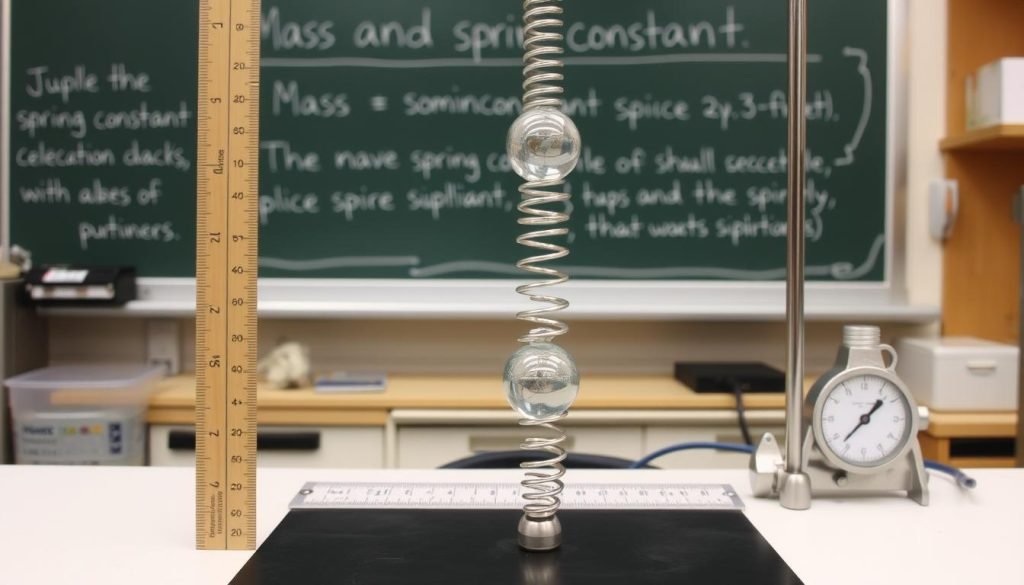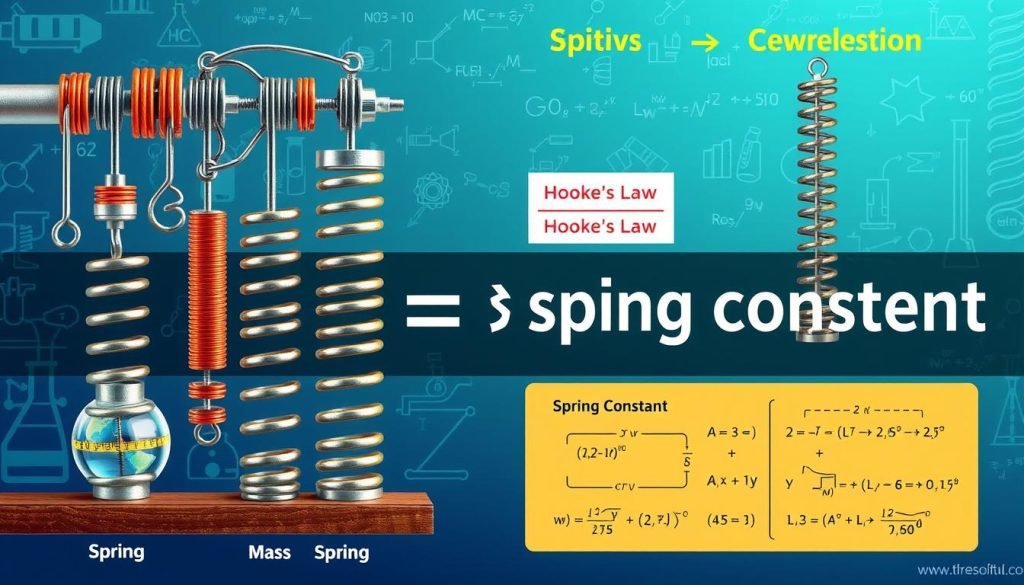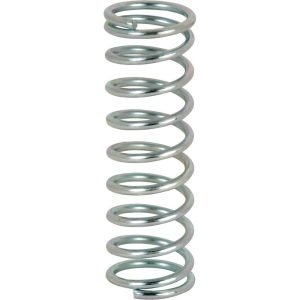The spring constant is a key idea in physics and engineering. It shows how force and displacement are linked in springs. Knowing about the spring constant is vital in many areas because it lets us predict how springs behave under different situations.
The spring constant is tied to Hooke’s Law. This law says that the force needed to stretch or compress a spring is directly related to its displacement. The mass of an object attached to a spring also affects the spring constant.
Understanding the link between mass and spring constant is important. The spring constant measures how stiff a spring is. Hooke’s Law tells us that the spring constant is key in figuring out the force needed to move a mass attached to a spring. The mass of the object impacts the spring’s behavior, making it key to know how mass influences the spring constant.
In the next parts, we’ll dive into the world of springs. We’ll look closely at the spring constant and its connection to mass. By studying Hooke’s Law and the physical properties of springs, we’ll understand how mass impacts the spring constant. This will help us see the complex relationships between springs, forces, and masses.
Understanding the Basics of Springs and Forces
Learning about springs starts with understanding the spring constant calculation. This is based on Hooke’s Law, which links the force on a spring to its displacement. Knowing the basics of springs and forces is key to this understanding.
Springs resist deformation when a force is applied. This resistance lets springs store energy. The spring constant shows how stiff a spring is. A higher constant means a stiffer spring, while a lower one means a more flexible one.
What is a Spring Constant?
A spring constant measures the force needed to deform a spring by a certain distance. It’s vital for understanding springs. Knowing the spring constant helps engineers design and predict spring behavior in different situations.
Introduction to Hooke’s Law
Hooke’s Law says the force needed to deform a spring is directly related to the deformation distance. It’s written as F = kx, where F is the force, k is the spring constant, and x is the deformation distance. This law is a cornerstone in spring physics and helps calculate the spring constant.
Basic Terms and Definitions
It’s important to know the basic terms and definitions in spring physics. Key terms include:
- Spring constant: a measure of a spring’s stiffness
- Force: a push or pull that causes deformation
- Displacement: the distance a spring is deformed
- Hooke’s Law: the principle that describes the relationship between force and displacement
The Physical Properties of Springs
Understanding mass and springs requires knowing their physical properties. The spring constant is key in how springs react to forces. Material, size, and shape all influence the spring constant and the spring’s behavior.
The material of a spring greatly affects its properties. A stiff material spring has a higher spring constant than a flexible one. The size and shape also matter, with longer, thinner springs having a lower spring constant than shorter, thicker ones.
There are many types of springs, each with its own use:
- Compression springs: used in shock absorbers and suspension systems
- Extension springs: used in garage doors and trampolines
- Torsion springs: used in clocks and mousetraps
Knowing a spring’s physical properties is vital for designing systems with mass and springs. Engineers use the spring constant and other properties to make systems safe, efficient, and effective. Studying these properties is key in physics and engineering, important for many applications.
The link between physical properties and the spring constant is complex. By looking at how physical properties affect the spring constant, we understand mass and springs better. This knowledge helps in designing systems that use springs’ unique properties.
| Spring Type | Physical Properties | Spring Constant |
|---|---|---|
| Compression Spring | Stiff material, long and thin | High |
| Extension Spring | Flexible material, short and thick | Low |
| Torsion Spring | Stiff material, coiled shape | Medium |
Does Mass Affect the Spring Constant? The Scientific Answer
Exploring the link between mass and spring constant is key. The question of does mass affect the spring constant has sparked interest in physics. Studies have shed light on this topic, showing that the spring constant doesn’t change with mass.
Hooke’s Law explains how springs work. It says the force a spring applies is directly related to how far it’s stretched. This law holds true, proving that the spring constant stays the same, no matter the mass attached.
Key Findings
- The spring constant is a property of the spring itself and does not depend on the mass attached to it.
- Experimental evidence confirms that the spring constant remains constant, regardless of the mass used in the experiment.
- A mathematical relationship can be used to describe the behavior of springs, which is essential for understanding the physics behind spring constants.

In conclusion, the scientific answer to does mass affect the spring constant is no. The spring constant is a fundamental property of the spring. Its value doesn’t change, no matter the mass attached. This knowledge is vital for using spring constants in physics and engineering.
The Mathematics Behind Spring Constants
To understand springs, we must explore their math. The spring constant calculation is key in physics. It shows how springs react to forces. This is based on the force-distance relationships between the spring and the applied force.
Hooke’s Law is at the heart of spring behavior. It says the force needed to stretch or compress a spring is directly related to its displacement. These mathematical models help us see how springs act under different conditions.
- Understanding the relationship between force and distance
- Calculating the spring constant using mathematical formulas
- Applying mathematical models to real-world scenarios
Knowing the math behind spring constants helps us understand their behavior. This knowledge is vital in engineering and physics. It’s used to design and improve systems that use springs.
Factors That Actually Influence Spring Constants
Understanding spring constants requires looking at several key factors. Physical properties like the spring’s material and size are very important. Also, material properties such as elasticity and stiffness play a big role.
The factors affecting spring constants can be grouped into a few main areas. These include:
- Wire diameter and material
- Coil diameter and shape
- Number of coils and spring length
By adjusting these factors, engineers can make springs with the right constant. This is why knowing how they work is so important.
By examining these factors affecting spring constants
Real-World Applications of Spring Constants
Spring constants are key in many areas. They are vital in automotive suspension systems and industrial uses. Knowing about spring constants helps in making systems work better.
Automotive Suspension Systems
Spring constants are important in car suspension. They help make the ride smooth and keep the car stable. The spring constant affects how well a suspension system handles bumps.
Industrial Applications
Spring constants are used in machinery and equipment. Springs help store energy, absorb shocks, or apply force. Knowing about spring constants is important for safe and efficient use.
Scientific Instruments
Spring constants are used in scientific tools like seismometers and microbalances. They help measure small changes in force or movement. Understanding spring constants is key for these instruments’ accuracy.
Experimental Methods for Measuring Spring Constants
Understanding springs is key in many fields. Experimental methods help figure out how stiff a spring is. These methods use scientific instruments to apply forces and measure how much the spring moves.
Researchers often use force sensors, displacement sensors, and spring constant testers. These tools help them apply exact forces and measure how much the spring moves. This lets them find the spring constant.
They also use dynamometers and load cells to measure spring constants. These tools give precise force and displacement readings. This helps researchers calculate the spring constant accurately. By using these experimental methods and scientific instruments, they learn more about springs and their uses.
- Force sensors
- Displacement sensors
- Spring constant testers
Knowing how to measure spring constants helps researchers create new springs. This leads to big improvements in engineering and physics. Using scientific instruments and experimental methods is vital for measuring spring constants and studying springs.
The Role of Temperature and Environmental Factors
When we talk about the spring constant, we must think about temperature and environment. These things can really change how springs work. Temperature can make springs expand or shrink, which changes their spring constant.
Things like corrosive substances or too much humidity can also hurt springs. To fight these problems, we need to pick the right materials and designs. This way, springs can keep working well, even in tough conditions.
Here are some important things to think about when dealing with temperature and environment and springs:
- Material selection: Choose materials that don’t expand much with heat and resist corrosion well
- Design parameters: Make the spring design so it handles stress better and works better
- Environmental testing: Test the spring to make sure it can handle the expected environment
By thinking about these points and taking steps to deal with temperature and environment, engineers can keep the spring constant stable. This leads to better performance and efficiency. Here’s a table showing why we need to think about temperature and environment in spring design:
| Factor | Impact on Spring Constant |
|---|---|
| Temperature effects | Can cause expansions or contractions, altering the spring constant |
| Environmental considerations | Can impact the spring’s durability and performance, affecting the spring constant |
Common Mistakes in Spring Constant Calculations
When you’re working on spring constant calculations, knowing common mistakes is key. These errors can make your results wrong and hurt how well the spring works. A big mistake is using the wrong mathematical models. These models are important because they help us understand how the spring will act under different situations.
Some common mistakes include taking wrong measurements of the spring, ignoring how the environment affects it, and using the wrong formulas. To avoid these, it’s important to carefully check the models you’re using and make sure you’re measuring everything right. This way, engineers can make sure their spring constant calculations are correct and dependable.
Here are some tips to avoid common mistakes in spring constant calculations:
- Double-check measurements and calculations
- Use correct mathematical models and formulas
- Consider environmental factors that may affect the spring’s behavior

By following these tips and knowing about common mistakes, engineers can make sure their spring constant calculations are right. This leads to better performance and safety in many uses.
| Common Mistake | Correction |
|---|---|
| Incorrect measurement of spring dimensions | Use precise measurement tools and techniques |
| Neglecting environmental factors | Consider temperature, humidity, and other environmental factors that may affect the spring’s behavior |
| Using incorrect formulas | Review and apply correct mathematical models and formulas |
Best Practices for Spring Selection in Engineering
Choosing the right spring is key in engineering. The material used is very important. For example, high-carbon steel springs are strong and last long.
Design matters too. The spring’s size, shape, and how it’s set up are all important. Engineers must think about the load, temperature, and environment. This ensures the spring works well and lasts.
Material Considerations
- High-carbon steel for high-strength applications
- Stainless steel for corrosion-resistant applications
- Aluminum for lightweight applications
Design Parameters
Designing the spring right is critical. It must handle the expected loads and conditions. This includes the spring’s stiffness and how much stress it can take before deforming.
Safety Factors
Keeping safety in mind is also important. Engineers must think about what could go wrong if the spring fails. By choosing wisely, they make sure their designs are safe and work well.
Conclusion: Understanding the True Relationship Between Mass and Springs
The connection between mass and springs is complex and interesting in physics. It’s often thought that mass directly affects the spring constant. But, we’ve found that’s not true. The spring constant really depends on the spring’s material and design, not the mass it holds.
Learning about Hooke’s Law and spring behavior models helps us predict and control spring performance. This is important in many areas, like car suspensions and scientific tools. Things like temperature and the right spring choice also matter a lot.
In the end, mass doesn’t change the spring constant. Knowing this helps engineers and scientists make better spring systems. This knowledge is key to using springs to their best in many fields.






